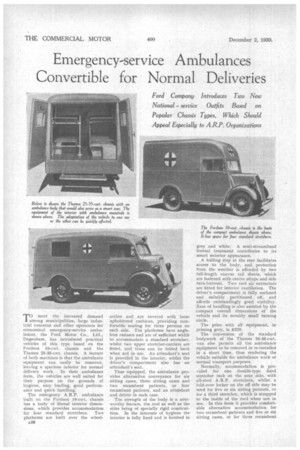Emergency-service Ambulances Convertible for Normal Deliveries
Page 40

Page 41

If you've noticed an error in this article please click here to report it so we can fix it.
TO meet the increased demand among municipalities, large industrial concerns and other operators for economical emergency-service ambulances, the Ford Motor Co., Ltd., Dagenham), has introduced practical vehicles of this type based on the Fordson 10-cwt. chassis and the Thames 25-35-cwt. chassis. A feature of both machines is that the ambulance equipment can easily be removed, leaving a spacious interior for normal delivery work. In their ambulance form, the vehicles are well suited for their purpose on the grounds of hygiene, easy loading, good performance and quick handling: The eniergency A.R.P. ambulance built on the Fordson 10-cwt. chassis has a body of liberal interior dimensions, which provides accommodation for four standard stretchers. Two platforms are built over the wheel
A38 arches and are covered with loose upholstered cushions, providing comfortable seating for three persons on each side. The platforms have angleiron runners and are of sufficient width to accommodate a standard stretcher, whilst two upper stretcher-carriers are fitted, and these can be folded back when not in use. An attendant's seat is provided in the interior, whilst .the driver's compartment also has an attendant's seat.
Thus equipped, the ambulance provides alternative conveyance for six sitting cases, three sitting cases and two recumbent patients, or four recumbent patients, and an attendant and driver in each case.
The strength of the body is a noteworthy feature, the roof as well as the sides being of specially rigid construction. In the interests of hygiene the interior is fully lined and is finished in
grey and white. A semi-streamlined frontal treatment contributes to its smart exterior appearance.
A folding step at the rear facilitates access to the body, and protection from the weather is afforded by two full-length canvas tail sheets, which are fastened with centre straps and side turn-buttons. Two roof air extractors are fitted for interior ventilation. The driver's compartment is fully enclosed and suitably partitioned off, and affords outstandingly good visibility. Ease of handling is also assisted by the compact overall dimensions of the vehicle and its notably small turning circle.
The price with all equipment, in priming grey, is £220.
The conversion of the standard bodywork of the Thames 2,5-35-cwt. van also permits all the ambulance equipment to be removed or re-installed in a short time, thus rendering the vehicle suitable for ambulance work or normal transport purposes.
Normally, accommodation is provided for one double-type fixed stretcher rack on the near side, with all-steel A.R.P. stretchers, whilst a. fold-over locker on the off side may be used for five or six sitting patients, cr for a third stretcher, which is strapped to the inside of the roof when not in use. In this form it provides comfortable alternative accommodation for two recumbent patients and five or six sitting cases, or for three recumbent
patients, with an attendant and driver in each case. A portable stretcher rack and steel stretcher may, however, be fitted in addition, providing for four recumbent patients.
Adequate natural lighting inside the body is provided by two large adjustable Purdah glass windows, whilst an electric moonstone lamp fitted to the partition is an excellent auxiliary. An air extractor is fitted to the roof and hit-and-miss louvres are provided in the rear doors; additional ventilation can be obtained by lowering the side windows. Interior equipment includes a mahogany holder fitted with a water-bottle and glass, and a firstaid kit and set of splints. A fixed step is fitted at the rear of the body.
The driver's compartment is partitioned off, and fitted with a communication panel. An attendant's seat is provided.
The Thames 25-35-cwt. van is speci ally suitable for such a conversion, as it proVides exceptional ease of handling and manoeuvrability, combined with generous body capacity; its dimensions are length 8 ft. 4 ins., width 5 ft. 4 ins., height 4 ft. 10 ins.
Completely modified and equipped as described, the ambulance is priced at £305. A fourth stretcher and rack Can be provided for £7 10s., whilst lining the interior of the body with plywood costs £10 extra..




































































